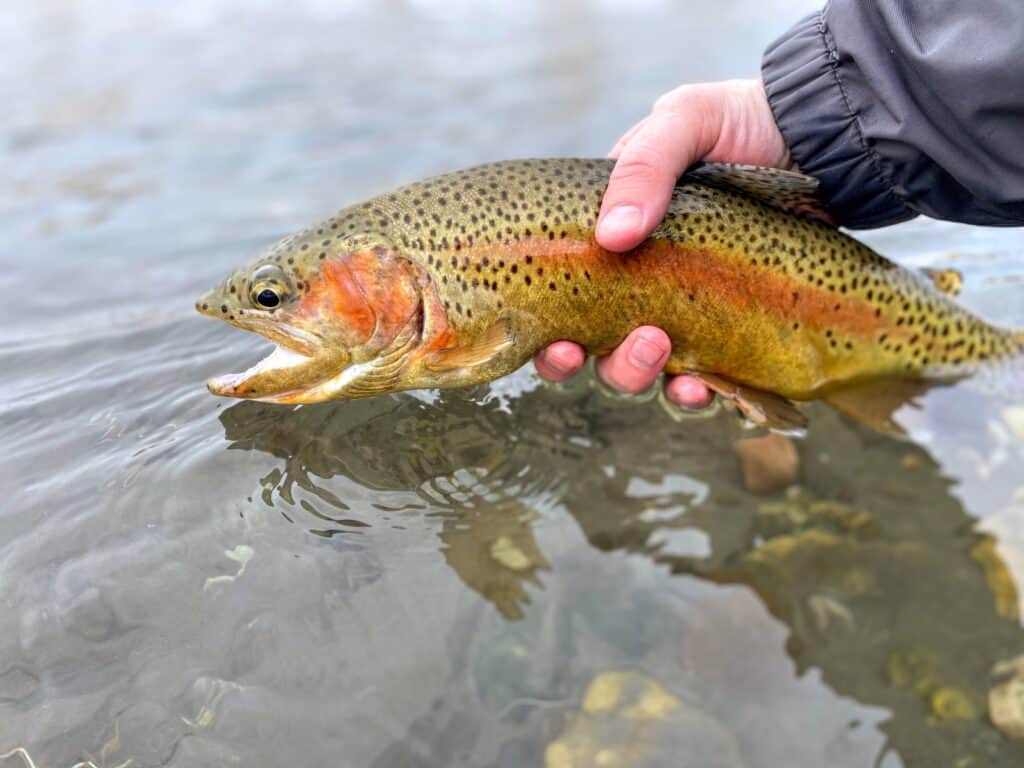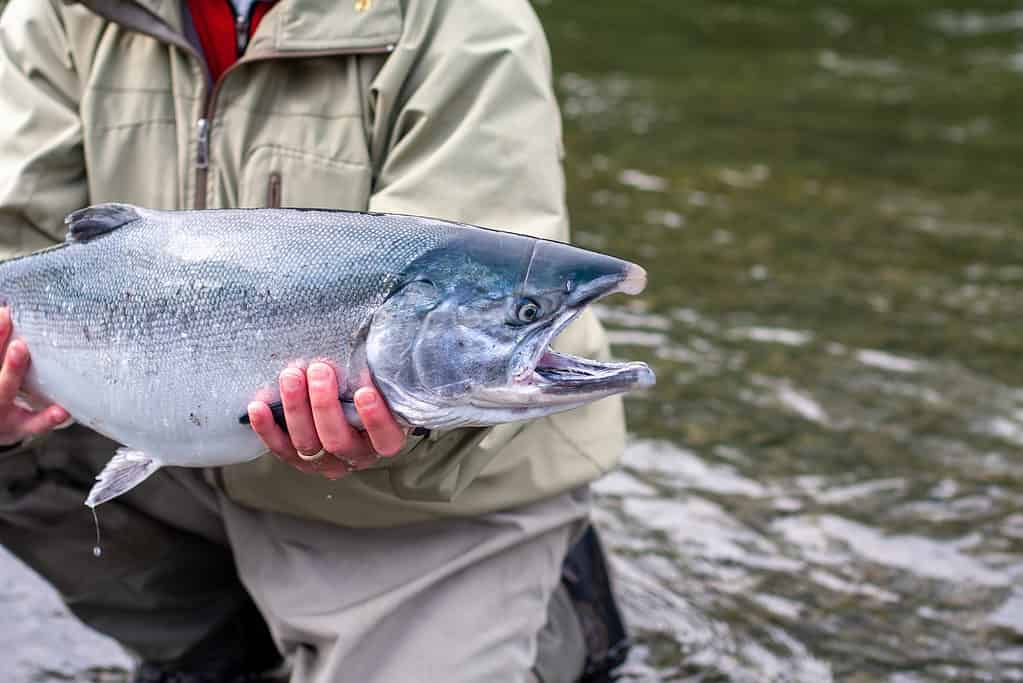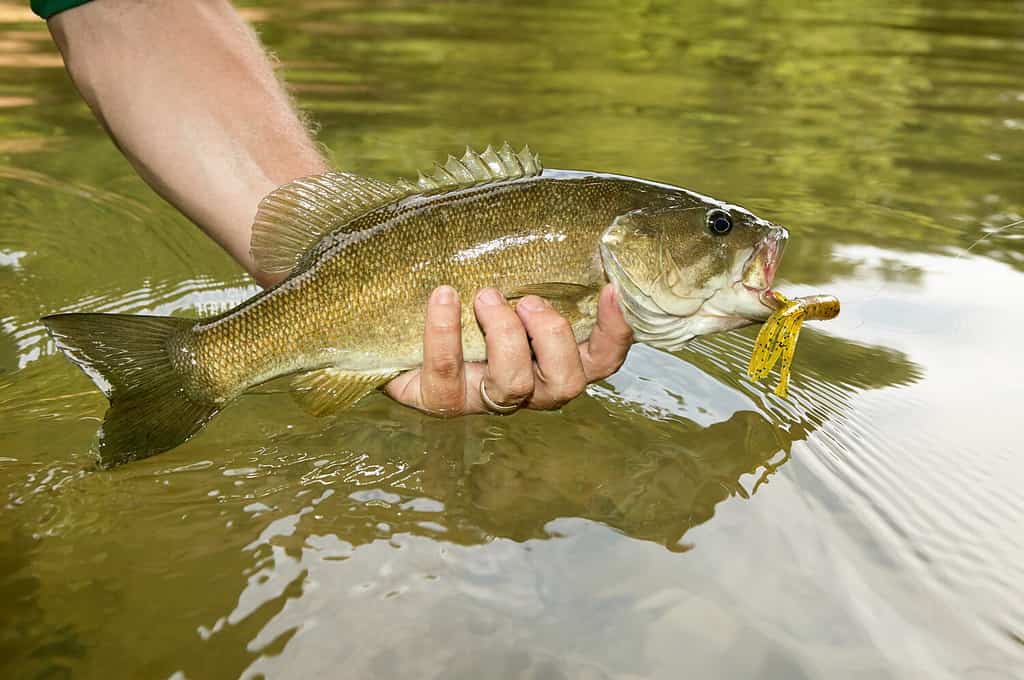Lake Washington, the second-largest natural lake in Washington, is a freshwater lake between Seattle and Bellevue, in King County. The lake offers plenty to do in terms of recreation such as boating, swimming, kayaking, and bicycling/running/walking on the perimeter path. Here, however, fishing is a premium sport. Fishing is open year-round on Lake Washington, and dozens of species swim beneath the surface. Let’s discover the five amazing fish living in Lake Washington.
1. Cutthroat Trout

Green, gold, and gray are typically the most prominent hues of the cutthroat trout.
©Ryan Cuddy/Shutterstock.com
Lake Washington enjoys a healthy, sustainable population of cutthroat trout. The “resident coastal cutthroat trout” is one of three subspecies of the cutthroat trout found in Washington and one of two that are native.
Often mistaken for rainbow trout, cutthroat trout possess two prominent features that rainbows do not. One is that the cutthroat’s lower jaw is marked with red slashes on each side and tiny teeth on the back of the tongue. The second is that the cutthroat’s upper jaw extends past the back edge of the eye (and rainbows do not).
The average length of a Lake Washington cutthroat trout is 7-9 inches, but they can grow as long as 18 inches in certain areas. Their lifespan is between six and eight years, and they weigh anywhere from four ounces to six pounds.
You can fish for cutthroat trout from the bank or a public fishing dock, but they are best caught by boat. The reason a boat is advantageous is because the cutthroat trout prefer the mid-lake waters in the upper 20 feet of depth.
They can be caught any time of year, but the best time for success is from October to April. Almost any area of Lake Washington is a good choice for fishing these trout, but some experts advise putting your boat downwind to either the I-90 or the 520 floating bridges. Because the lake can easily get choppy with only a minuscule amount of wind, you will experience a calmer fishing troll with these floating bridges acting as a windbreak.
In the winter, cutthroat trout feed off of midges which are tiny insects that rise to the surface to hatch. In the spring, out-migrating salmon smolt is what the cutthroat trout craves.
2. Yellow Perch

The female yellow perch grows faster and larger than the males.
©Maximillian cabinet/Shutterstock.com
Yellow perch fishing is a win-win situation on Lake Washington. The lake possesses so much of this population that a couple of years ago there were no limit quotas. Even now, the perch limits are extremely high.
These fish have a slender, oval body with a blunt snout. Gold or yellow, these perch have 6-8 dark, vertical, thick lines along the side of the body. They also have two separate dorsal fins like most perch. The females grow faster and reach a larger adult size than males. As well, they are typically 6-10 inches long and weigh one-half to one pound. They typically live up to 10-11 years.
Many laud the yellow perch as “the ultimate pan fish,” as they are delicious with a mild, sweet flavor and firm but flaky texture. Yellow perch are active on Lake Washington all year long, even during the bitter winter months. July through September is the optimum season to fish for them.
They favor deeper waters, so fishing off of the bottom is ideal. Yellow perch aren’t too picky with their diet; they eat minnows crayfish, water bugs, and fish eggs, for a few examples.
3. Salmon: Coho and Kokanee

Coho salmon are sometimes called silver salmon.
©iStock.com/christiannafzger
Sockeye salmon used to be the “big catch” on Lake Washington, but populations of this species have dwindled due to overfishing, invasive species, and warmer-than-average temperatures in recent years.
The salmon that are currently caught most on Lake Washington are coho and kokanee. Coho salmon travel from Puget Sound through Ballard Locks to the lake and are large, typically 8-12 pounds and 24-30 inches long. Kokanee salmon live solely in freshwater and tend to be closer to typical trout in size (one pound, 9-12 inches long).
The coho season is brief, running September 16 through October 31, with a daily quota of four per day. Additionally, coho smaller than 12 inches have not grown to maturity and are therefore prohibited. Adult coho salmon are bigger and stronger than trout although these two fish are similar in many ways.
As coho can be aggressive, anglers suggest inciting them to attack. Spinners and twitching jigs work well to agitate coho but don’t forget their strength. You will need a stronger line than you use for bass or trout fishing as well as a rod to catch fish beyond 10 pounds.
Kokanee salmon are sockeye salmon that never migrate to the ocean. Late spring is the best time to catch them when they’re consuming plankton. In the summer, coho will migrate into Lake Washington’s deep waters. Fall is also a decent time to fish for coho although they don’t taste as good when caught during this time of year.
You cannot keep any coho that are longer than 18 inches or shorter than eight inches. Similar to the coho, kokanee are aggressive and react combatively to bright and flashy water activity.
4. Bass: Smallmouth and Largemouth

Lake Washington is a great place to catch both smallmouth and largemouth bass.
©CLP Media/Shutterstock.com
Bass fishing in Washington and the Pacific Northwest is relatively new and has exploded in the past decade or so. Lake Washington is still underutilized for smallmouth, yet it is as good as any lake in the state for it. While available year-round, the smallmouth bass season picks up in April, with May and June being the peak months. Smallmouth fishing continues strong through September or October.
The smallmouth’s jawline extends to its eye, and three brown vertical bands lie along its black, green, or brown sides. Smallmouths grow up to 30 inches long and are between two to three pounds.
Largemouth bass are generally larger and have considerably wider mouths than smallmouth. They are scavengers, eating almost everything they come across. Largemouth are light to dark green, with dark horizontal blotches on each side. Its underbelly is light green to white.
On average, the largemouth bass grows 4-8 inches during its first year of life, up to 14 inches in its second, and up to 18 or more inches in three years. An adult largemouth weighs around 12 pounds.
5. Black Crappie

The accessibility and flavor of black crappie make them a prize game fish.
©M Huston/Shutterstock.com
Black crappie is popular with fishermen because not only are they relatively easy to catch, but they are also excellent to eat, considered a delicacy with a mild, sweet flavor. Black crappie are dark green and identifiable by their large rounded dorsal fins and deep, narrow bodies. The average black crappie’s length is around 11 inches and weighs around three pounds. The heaviest recorded weight for a black crappie is six pounds.
Spring is the prime time to fish for black crappie at Lake Washington because they travel in schools. Summer slows down a bit but fall improves success due to cooler waters, dying vegetation, and more available prey. Although winter slows down a bit, fishermen can have success year-round.
Summary of the 5 Amazing Fish Living in Lake Washington
| Fish | Average Length/Weight | Best Time to Fish |
|---|---|---|
| Cutthroat Trout | 7-9 inches/2-5 pounds | October-April |
| Yellow Perch | 6-10 /1 pound | July-September |
| Salmon: Coho | 8-12 pounds/24-32 inches | September 16-October 31 |
| Salmon: Kokanee | 1 pound/9-12 inches | Late spring |
| Bass: Smallmouth | 2-3 pounds/8-22 inches | May-June |
| Bass: Largemouth | 12 pounds/16 inches | May-June |
| Black Crappie | 3 pounds/11 inches | Spring |
The photo featured at the top of this post is © Cascade Creatives/Shutterstock.com
Thank you for reading! Have some feedback for us? Contact the AZ Animals editorial team.







